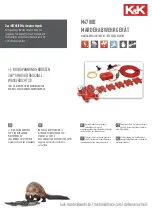
Of course, the relationship between the phase shift and the timing error is defined
by the frequency of the signal. If the sinewave frequency increases or decreases,
a given timing difference will lead to different relative phases between the signals.
This concept then leads to the following situation.
Consider two complex signals, such as those that represent music or speech.
Fourier analysis tells us that these can be represented by an infinite number of
sinewaves that represent all the frequencies present in the signal. So, for any
given timing difference between the left and right channels, each sinewave in the
signal will be phase-shifted by a different amount. Some will be added together
and thus become louder, most will be smeared across the stereo image, and
some will (if reproduced in mono) cancel out entirely. The result, when viewed on a
spectral analyser, looks exactly like a broad comb-filter, with the distance between
the ‘teeth’ of the comb defined by the size of the timing error. (Figure 6).
The distortion of these phase relationships and the consequent filtering effect
cause all the audible problems of timing errors. They include loss of high
frequencies, muddy bass, poor mono compatibility, and a general smearing of
the stereo image. Worse still, if the timing error is not precisely constant, you will
hear a ‘flanging’ effect caused by the ‘teeth’ of the comb filter sweeping
backwards and forwards through the spectrum.
Audio engineers have traditionally employed a range of processors to hide these
deficiencies: equalisers, stereo enhancers, dynamics processors and reverb
units. However, none of these attacks the heart of the problem – these small but
significant non-synchronisations of the left and right channels.
CEDAR
corrects these problems by eliminating the timing errors that cause them.
It does this by identifying any monophonic component in the stereo sound and
then measuring the timing difference between the left and right channels of the
signal.
If any such error is detected, the system recreates the signals such that they are
accurately aligned. The timing measurement is performed nearly fifty times a
second, and the signal is corrected dynamically according to each of these
measurements. Zipper noise and digital glitching are avoided by regenerating the
signal with an accuracy of 1% of a sample. Furthermore, a sophisticated filter
minimises the chance that the detector will be fooled by unusual signals that
contain little or no monophonic components, so that
CEDAR
should never generate
erroneous corrections and introduce phase/time errors of its own.
There is one other use for
CEDAR
’s phase/time correction products, and this is
related to broadband noise reduction. If you transcribe a monophonic signal held
on analogue tape or disc using a stereo tape-head or cartridge, you will create two
monophonic signals. Each of these will contain the desired signal, and some noise.
If you then time-align these channels and sum them to mono using
CEDAR
, you will
generate a monophonic signal in which the desired signal is 6dB louder than either
of the individual channels, but in which the broadband noise content may be as
little as 3dB louder. (This is a consequence of the random nature of broadband
noise.) As a result, you have given yourself a head start of (up to) a 3dB increase in
signal-to-noise ratio before you attempt noise reduction on the signal.
PAGE 26
Содержание AZX+
Страница 4: ......
Страница 6: ......
Страница 7: ...PART 1 Operations manual ...
Страница 12: ...PAGE 6 CEDAR BRX debuzzer 1 2 3 4 10 11 12 13 14 CEDAR AZX azimuth corrector 1 2 5 6 7 8 9 14 ...
Страница 14: ......
Страница 15: ...The BRX debuzzer ...
Страница 19: ...The AZX azimuth corrector ...
Страница 25: ...PART 2 An introduction to audio restoration ...
Страница 27: ...PAGE 21 Figure 2 Figure 3 Figure 1 ...
Страница 29: ...PAGE 23 Figure 5 Figure 4 ...
Страница 31: ...PAGE 25 Figure 2 Figure 3 Figure 1 Figure 4 ...
Страница 33: ...PAGE 27 Figure 6 Figure 5 ...
Страница 35: ......




































